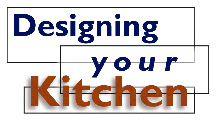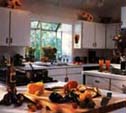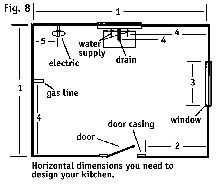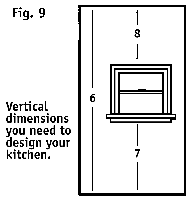 |
 |
 |
 |
 The first step in
kitchen layout is measuring your kitchen. You'll need to make a sketch of the room, using
graph paper and counting each square as 3". Measure the following dimensions:
The first step in
kitchen layout is measuring your kitchen. You'll need to make a sketch of the room, using
graph paper and counting each square as 3". Measure the following dimensions:
 HORIZONTAL DIMENSIONS:
HORIZONTAL DIMENSIONS:
(Fig. 8)
 1) Each wall from corner to corner;
1) Each wall from corner to corner;
2) From the nearest corner to the outside edge of each door or window casing;
3) The overall width of the doors and windows, including the casing;
4) From the nearest corner to the centers of water supply lines, drain lines and gas feed
lines;
5) From the nearest corner to the centers of electrical outlets and switches.
VERTICAL DIMENSIONS
(Fig.9)
 6) From the floor to the ceiling;
6) From the floor to the ceiling;
7) From the floor to the bottom edge of window stools or casings;
8) From the ceiling to the top edge of door and window casings.
Once you have those dimensions, you're ready to do a basic layout. First, make a few copies of your sketch, so you can play with different ideas. You can also make cardboard cutouts of your appliances, sink and basic cabinet sizes (to scale), and move them around on your sketch. Decide on the general location of each of the work centers. Make sure that the layout fits general kitchen planning guidelines, and that no structural or other considerations prevent you from building your layout.
 Next, determine the rough position of the
major appliances (refrigerator, range and ovens) and the sink. Double check the layout to
make sure you've allowed the proper amount of counter space in each work center, as
outlined above . Also, double check to make sure your work triangle is within guidelines.
Next, determine the rough position of the
major appliances (refrigerator, range and ovens) and the sink. Double check the layout to
make sure you've allowed the proper amount of counter space in each work center, as
outlined above . Also, double check to make sure your work triangle is within guidelines.
Plan a sink base cabinet under the sink, then choose the types of cabinets that will go near each appliance. Work from the nearest corner to the sink and each appliance, sizing the cabinets so you are left with a gap at the end that is less than 3". You'll use a filler strip that matches the cabinet finish to fill those gaps.
Make sure each type of cabinet fits the need at that work center - mixing bowl and utensil storage near the mixing/preparation center, cooking utensils near the range, and dish storage near the sink, for example.
Finally, add up the materials you will need - cabinets, countertops, appliances, electrical, plumbing and heating supplies, light fixtures, fan and all the surface materials such as floor coverings, wallboard, wallpaper and paint.
T O O L A N D M A T E R I A L C H E C K L I S T
| Steel Measuring Tape | Graph Paper | Straightedge |
| Square |
Check your state and local codes before starting any project. Follow all safety precautions. Information in this document has been furnished by the National Retail Hardware Association. Every effort has been made to ensure accuracy and safety. Neither the NRHA nor the retailer can be held responsible for damages or injuries resulting from the use of the information in this document.